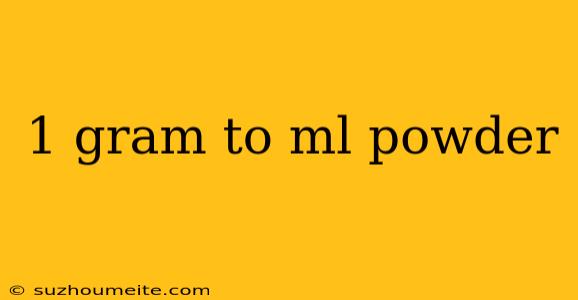1 Gram to ML Powder: Understanding the Conversion
When working with powders, it's essential to understand the conversion between weight (grams) and volume (milliliters). This article will guide you through the conversion of 1 gram to milliliters (mL) for powders.
Why is the Conversion Important?
In pharmaceutical, cosmetic, and food industries, accurate measurements are crucial. A small mistake in measurement can lead to significant errors in the final product. Understanding the conversion between grams and milliliters helps ensure accurate dosing, mixing, and packaging.
The Conversion Formula
To convert 1 gram to milliliters, you need to know the density of the powder. The formula is:
Volume (mL) = Mass (g) / Density (g/mL)
For example, if you have a powder with a density of 0.5 g/mL, the conversion would be:
1 g ÷ 0.5 g/mL = 2 mL
This means that 1 gram of the powder is equivalent to 2 milliliters.
Factors Affecting the Conversion
Several factors can affect the conversion, including:
Density
As mentioned earlier, density plays a significant role in the conversion. Different powders have varying densities, which affect the volume.
Particle Size
The size and shape of the powder particles can impact the conversion. Finer particles can settle more densely, affecting the volume.
Moisture Content
The moisture content of the powder can influence the conversion. Powders with higher moisture content may occupy more volume than those with lower moisture content.
Compaction
The way the powder is compacted can also affect the conversion. Compacting the powder can decrease the volume, while loose powder may occupy more space.
Real-World Applications
Understanding the conversion of 1 gram to milliliters is crucial in various industries, such as:
Pharmaceuticals
Accurate measurements are vital in pharmaceutical manufacturing to ensure the correct dosage and efficacy of medications.
Cosmetics
In the cosmetic industry, precise measurements are necessary to achieve the desired texture and consistency of products.
Food Industry
In food production, accurate measurements ensure the correct proportion of ingredients, which affects the final product's quality and safety.
Conclusion
In conclusion, understanding the conversion of 1 gram to milliliters for powders is essential in various industries. By considering the factors that affect the conversion, you can ensure accurate measurements and produce high-quality products. Remember to always consult the specific density of the powder you are working with to ensure accurate conversions.
